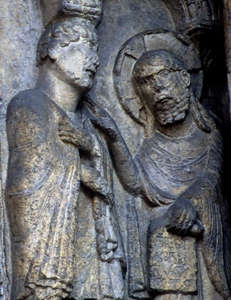*Call for Papers: *
*45th International Congress on Medieval Studies*
*May 13–16, 2010***
*Western Michigan University/ Kalamazoo*
*MEARCSTAPA (Monsters: The Experimental Association for the Research of
Cryptozoology through Scholarly Theory and Practical Application) *is
sponsoring two sessions at the 45th International Congress on Medieval
Studies (May 13–16, 2010). The call for papers and the contact details for
each session are below. All abstracts will also be made available for
viewing on the MEARCSTAPA blog (http://medievalmonsters.
*1. The Monstrous, the Marvelous, and the Miraculous*
Much critical attention is currently being directed at the monstrous in the
Middle Ages, but the category is, by its very nature, difficult to define.
It
bleeds at the edges into other fundamental categories, most notably the
marvelous and the miraculous. On one end of this spectrum, we find
horrifying, homophagic nightmares and, on the other, direct evidence for the
power and mercy of God.
While these two extremes seem, at a glance, to have little in common, they
both were marvelous, deserving and inspiring our wonder on account of lying
outside of the realm of the everyday. Both were therefore viewed as signs of
God's divinity and divine plan for the universe. In this session, we will
interrogate the blurred boundaries between these richly ambiguous
epistemological categories, not striving to artificially sharpen their
boundaries but rather, seeking greater nuance in our understandings of all
three.
Please send abstracts of 300 words, along with a completed Participant
Information Form (
http://www.wmich.edu/medieval/
Melissa Ridley-Elmes at melissaelmes@carlbrook.org by 1 September 2009.
*2. Unexpected Monsters: Close Encounters of the Other Kind *
Typically, in medieval imagination, monsters appear in liminal spaces, in
spaces outside of the civilized realm of the court. In literature they might
appear in the forests and deserts, or in the mountain ranges, while on
medieval maps they might appear in peripheral spaces, in the uncharted
regions on the edges of the world. In such instances, they often represent
all that is other, different, dangerous... the unknown. But what happens
when the monster is local? Internal? This panel proposes to explore
instances of unexpected monstrosity or otherness within within medieval
imaginings—instances of difference that occur at the level of the local and
familiar, or within the self. Papers are invited that explore such
interpretations of monstrosity within literature, art, and architecture (or
in medieval culture at large).
Please send abstracts of 300 words, along with a completed Participant
Information Form (
http://www.wmich.edu/medieval/
Renée Ward at rmward@ualberta.ca by 1 September 2009.
CFP: “Spanish Interpretations of the Apocalypse: Exegesis, Text, and Image
How do Spanish interpretations of the Apocalypse in theological, exegetical, literary, and iconographical works distinctively respond to Iberian historical contexts? Do Spanish interpretations of the Apocalypse differ from those of other regions of Europe? These questions suggest the exploration of themes such as (but not limited to) the relationships between texts and apocalyptic iconography, popular and orthodox appropriations of apocalyptic prophecies and/ or images, the image of the Antichrist in the evolution of anti-heretical discourse in the context of the Reconquest, the didactic and/ or propagandistic aspirations in literary and/ or iconographic treatments of eschatological sources.
Please submit an abstract (200-300 words) to Patricia Timmons at ptimm@tamu..edu by 15 September 2009.
Please include a completed Participant Information Form (see http://www.wmich.edu/medieval/
Immersion dans le quotidien des nouveaux prêtres de 2022
-
À l’heure où de profondes réflexions traversent le monde catholique, les
ordinations de juin ont une résonance particulière. À Nantes, à Sarcelles,
à Orl...
Il y a 3 ans
+02-10-11.jpg)

0 comments:
Enregistrer un commentaire